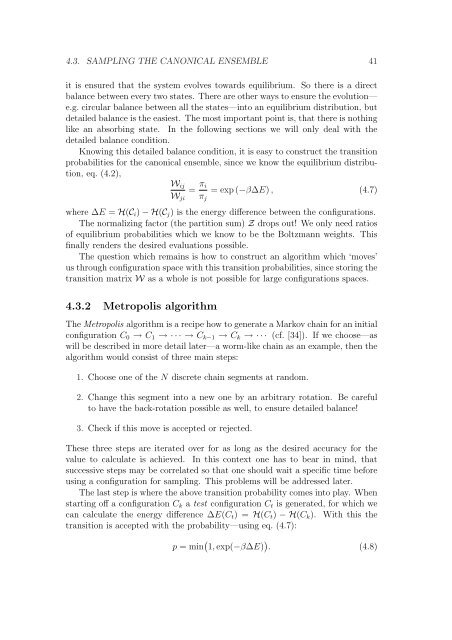Polymers in Confined Geometry.pdf
Polymers in Confined Geometry.pdf
Polymers in Confined Geometry.pdf
You also want an ePaper? Increase the reach of your titles
YUMPU automatically turns print PDFs into web optimized ePapers that Google loves.
4.3. SAMPLING THE CANONICAL ENSEMBLE 41<br />
it is ensured that the system evolves towards equilibrium. So there is a direct<br />
balance between every two states. There are other ways to ensure the evolution—<br />
e.g. circular balance between all the states—<strong>in</strong>to an equilibrium distribution, but<br />
detailed balance is the easiest. The most important po<strong>in</strong>t is, that there is noth<strong>in</strong>g<br />
like an absorb<strong>in</strong>g state. In the follow<strong>in</strong>g sections we will only deal with the<br />
detailed balance condition.<br />
Know<strong>in</strong>g this detailed balance condition, it is easy to construct the transition<br />
probabilities for the canonical ensemble, s<strong>in</strong>ce we know the equilibrium distribution,<br />
eq. (4.2),<br />
Wij<br />
Wji<br />
= πi<br />
πj<br />
= exp (−β∆E) , (4.7)<br />
where ∆E = H(Ci) − H(Cj) is the energy difference between the configurations.<br />
The normaliz<strong>in</strong>g factor (the partition sum) Z drops out! We only need ratios<br />
of equilibrium probabilities which we know to be the Boltzmann weights. This<br />
f<strong>in</strong>ally renders the desired evaluations possible.<br />
The question which rema<strong>in</strong>s is how to construct an algorithm which ‘moves’<br />
us through configuration space with this transition probabilities, s<strong>in</strong>ce stor<strong>in</strong>g the<br />
transition matrix W as a whole is not possible for large configurations spaces.<br />
4.3.2 Metropolis algorithm<br />
The Metropolis algorithm is a recipe how to generate a Markov cha<strong>in</strong> for an <strong>in</strong>itial<br />
configuration C0 → C1 → · · · → Ck−1 → Ck → · · · (cf. [34]). If we choose—as<br />
will be described <strong>in</strong> more detail later—a worm-like cha<strong>in</strong> as an example, then the<br />
algorithm would consist of three ma<strong>in</strong> steps:<br />
1. Choose one of the N discrete cha<strong>in</strong> segments at random.<br />
2. Change this segment <strong>in</strong>to a new one by an arbitrary rotation. Be careful<br />
to have the back-rotation possible as well, to ensure detailed balance!<br />
3. Check if this move is accepted or rejected.<br />
These three steps are iterated over for as long as the desired accuracy for the<br />
value to calculate is achieved. In this context one has to bear <strong>in</strong> m<strong>in</strong>d, that<br />
successive steps may be correlated so that one should wait a specific time before<br />
us<strong>in</strong>g a configuration for sampl<strong>in</strong>g. This problems will be addressed later.<br />
The last step is where the above transition probability comes <strong>in</strong>to play. When<br />
start<strong>in</strong>g off a configuration Ck a test configuration Ct is generated, for which we<br />
can calculate the energy difference ∆E(Ct) = H(Ct) − H(Ck). With this the<br />
transition is accepted with the probability—us<strong>in</strong>g eq. (4.7):<br />
p = m<strong>in</strong> 1, exp(−β∆E) . (4.8)













